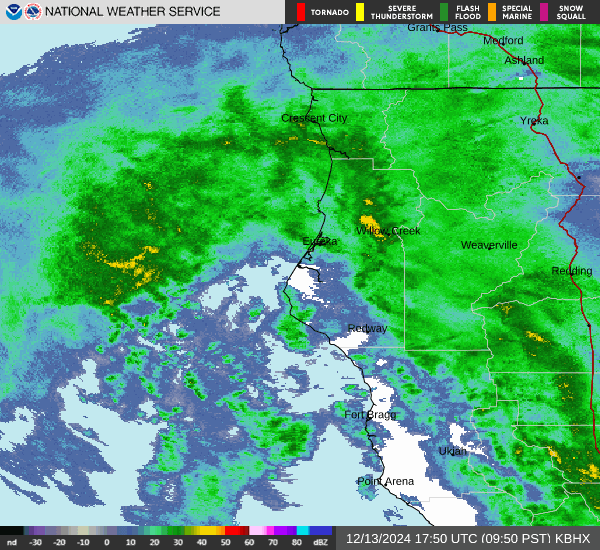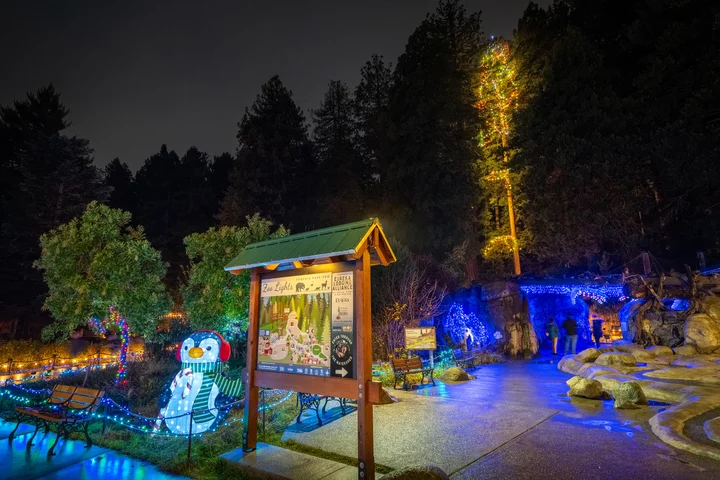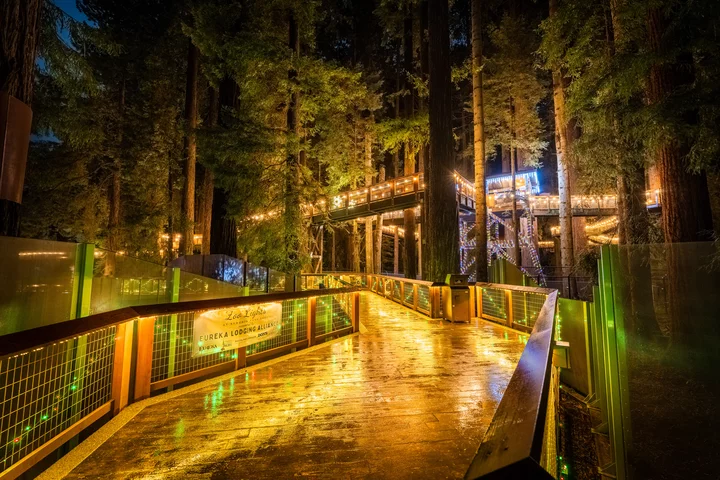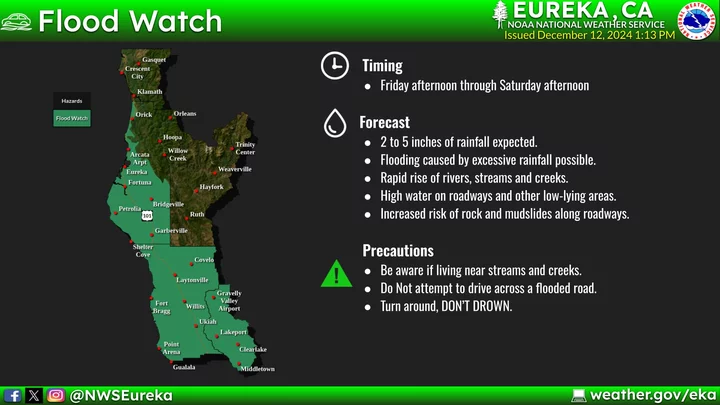There is Only One Tallest Living Lighted Christmas Tree In the World, and it is in Eureka
Hank Sims / Friday, Dec. 13, 2024 @ 1:44 p.m. / Celebration
Redwood > spruce. Photos: Sequoia Park Zoo, courtesy Davd Wilson.
Not to name names, but some some people who claim to have the “tallest living lighted Christmas tree in the world” are coming forward with a tree that is only 162 feet tall.
Laughable, man!
Eureka’s tallest living Christmas tree in the world — which appears to actually be the actual tallest one in the world — is a full 174 FEET and 9 INCHES tall, and it is projected to get taller still in the very near future.
That is a full 12 feet (and nine inches) taller.
And as of yesterday, that tree is lighted. And you are welcome to come marvel at it for a very reasonable fee.
Press release from the Sequoia Park Zoo:
The City of Eureka’s Sequoia Park Zoo kicked off the holiday season last night with a tree lighting like none other in the world. Led by Eureka City Manager, Miles Slattery, and attended by generous members of the Eureka Lodging Alliance and select guests, Sequoia Park Zoo illuminated its namesake tree (Sequoia sempervirens) for the upcoming Zoo Lights celebration.
Standing at 174 feet 9 inches tall, this iconic California coast redwood is believed to be the tallest living Christmas tree on the planet.
“We haven’t found a living, decorated tree anywhere that’s officially taller,” says Jim Campbell-Spickler, Sequoia Park Zoo Director. “And the beautiful thing about this redwood is that it is primed to keep growing. It could easily add between one and three feet annually, so I’ll just need to add more lights and adjust the star as it keeps getting bigger.”
Campbell-Spickler and two additional rope-access professionals spent days rigging, climbing, and decorating the tree with over 1,300 feet of lights. When a powerful 7.0 magnitude earthquake rocked Humboldt on the morning of December 5, 2024, Campbell-Spickler was at the top of the redwood installing the star.
“It was intense,” he says of the quake. “To be honest though, wind and rain are worse. Outside of the earthquake, weather delays definitely challenged our process, but I am so proud of what we accomplished with this incredible tree.”
The decorated redwood tree is located within Sequoia Park Zoo and is visible from Sequoia Park, W Street, and many of the adjacent neighborhoods during Zoo Lights extended hours. Presented by Eureka Lodging Alliance, Sequoia Park Zoo is excited to bring Zoo Lights back for another year of holiday magic, and we look forward to celebrating the season with our community!
Zoo Lights presented by Eureka Lodging Alliance opens on Saturday, December 14, 2024 and runs select nights through January 5, 2025. Tickets may be purchased at the Zoo ticket booth in advance or on the night of the event. Please note that adverse weather may require closure at any time. Visit redwoodzoo.org for event details and updates.
What: Zoo Lights presented by Eureka Lodging Alliance
When: Select nights December 14, 2024 - January 5, 2025 5:00p-8:00p, last entry at 7:30p
Where: Sequoia Park Zoo. 3414 W Street, Eureka, CA 95503
Cost: $5 per person ($4 EBT/BIC/WIC/Zoo members)
ABOUT SEQUOIA PARK ZOO
Founded in 1907, Sequoia Park Zoo is the oldest zoo in California and is home of the award-winning Redwood Sky Walk. Owned and operated by the City of Eureka and proudly accredited by the Association of Zoos & Aquariums (AZA), Sequoia Park Zoo is committed to the highest standards of animal care, conservation, and education. Sequoia Park Zoo cares for over 150 individual animals representing more than 50 diverse species. Sequoia Park Zoo inspires conservation of the natural world by instilling wonder, respect, and passion for wildlife and wild places. Visit redwoodzoo.org and redwoodskywalk.com for more information.
Pretty!
BOOKED
Today: 8 felonies, 11 misdemeanors, 0 infractions
JUDGED
Humboldt County Superior Court Calendar: Today
CHP REPORTS
3300 Mm101 S Hum 33.00 (HM office): Trfc Collision-Unkn Inj
Us101 S / Myers Flat Ofr (HM office): Trfc Collision-Unkn Inj
Summer Ln / Scenic Creek Dr (HM office): Missing Indigenous
ELSEWHERE
RHBB: Solo Vehicle Crashes Into Guardrail on 101 Between Myers Flat and Weott, According to CHP CAD
County of Humboldt Meetings: In-Home Supportive Services Advisory Board meeting - Nov. 24, 2025
County of Humboldt Meetings: In-Home Supportive Services Advisory Board meeting - Sept. 25, 2025
Fishing the North Coast : Another Storm, Another Miss: North Coast Still Waiting on a Real Rise
ALL RECORDS SMASHED! This Year’s Holiday Food Drive Was the Best Ever, At Least Until Next Year, Says Sen. Mike McGuire
LoCO Staff / Friday, Dec. 13, 2024 @ 1:23 p.m. / Activism
Press release from the office of Sen. Mike McGuire:
Senate Leader Mike McGuire’s 9th annual Humboldt Holiday Food Drive yet again smashed all records yesterday, bringing in a whopping 45,019 pounds of food and just over $56,000 to support the life-changing work of Food for People, Humboldt County’s food bank.
McGuire teamed up with Food for People, KHUM radio, North Coast News, Redwood News and six local high schools — Arcata, Eureka, Ferndale, Fortuna, McKinleyville, and St. Bernard’s — for the annual event, which is now the largest food drive on the North Coast.
The $56,000 raised from generous donors and community members — with donations still pouring in — will support Food for People’s 26 food pantries across Humboldt County, which feed 21,000 local residents each month. Over the past two years, demand for Food for People’s services is up by more than 30 percent.
“Yet again, Humboldt showed up in a big way to feed neighbors in need and make a HUGE difference in the lives of thousands. Let’s be clear — we live in the most generous place on Earth and we couldn’t be more grateful for the outpouring of support,” said Senator McGuire. “We owe a huge debt of gratitude to the incredible high school students who make this Food Drive possible, pounding the pavement and collecting thousands of pounds of food, along with the hundreds of generous neighbors who delivered another record-setting year. Thank you, Humboldt. You’re making the holidays brighter for thousands.”
Taking home the Golden Can Award again, McKinleyville High School had a clean sweep — collecting the most food this year with an eye-popping 23,356 pounds AND taking in the most contributions with $1,267 collected for Food for People. They will receive the coveted Golden Can Award and a $750 check from Senator McGuire for their efforts to be used towards their next school dance.
Last year, Food for People distributed over 2.4 million pounds of food to low-income households in every corner of Humboldt. The need is especially great for thousands of kids and seniors. Over a quarter of those served by Food for People are children who depend on others to have enough to eat.
“Every year, the Holiday Food Drive outdoes itself and the outpouring of food and funds from the community yesterday is truly amazing and we are so grateful! We owe special thanks to Senator McGuire and his team, our amazing high school student leaders, and the incredible donors who helped make this year’s food drive another record-breaking year,” said Carly Robbins, Executive Director of Food for People.
Here Comes the Rain! Flood Watch Issued for Humboldt Bay, Low-Lying Areas Along Eel River
Isabella Vanderheiden / Friday, Dec. 13, 2024 @ 12:20 p.m. / How ‘Bout That Weather

###
Get ready for a wet weekend, Humboldt!
The National Weather Service (NWS) has issued a flood watch for coastal communities and low-lying areas in the Eel River Valley where two to five inches of rain can be expected in the next 24 hours. Some areas of Southern Humboldt could see up to eight inches of rain in the same period.
“You should monitor later forecasts and be alert for possible flood warnings,” according to the NWS flood alert. “There will be an increased risk of rock and landslides along roadways. … Those living in areas prone to flooding should be prepared to take action should flooding develop.”
Humboldt County Public Works has already reported closures on some county-maintained roads, including Coffee Creek and Meridian roads in Ferndale. There’s also flooding reported on Pine Hill Road. The McCann Bridge is closed but the McCann Ferry is running.
Coastal communities should also be aware of King Tides, unusually high tides caused when the sun, moon and Earth align, creating a “stronger than normal gravitational pull” that can increase tides by one to two feet, according to the NWS. When coupled with storm surges, King Tides can dramatically increase the potential for coastal flooding and property damage.
Coastal flooding can be expected in low-lying areas of Humboldt Bay, particularly in King Salmon and along Jackson Road in the Arcata Bottoms.
If you happen to capture some photos of these super-high tides, send ‘em over to the California Coastal Commission! Those interested can submit their photos to the California King Tides Project at this link. If you do decide to go take photos, please do so safely.
There’s also a high wind advisory in effect for Humboldt and Del Norte counties. Winds ranging between 25 and 35 mph can be expected, with gusts up to 60 mph across higher elevations, according to the NWS. Take extra caution while driving, especially if you have a big vehicle.
Keep an eye on Caltrans Quickmap or the Caltrans District 1 Facebook page for current road conditions. We’ll update this post if we hear about any additional closures.
Stay safe, Humboldt!
Sheriff’s Office Seeks Public’s Help Locating Suspect in Attempted Homicide Committed Earlier This Year
LoCO Staff / Friday, Dec. 13, 2024 @ 11:10 a.m. / Crime
PREVIOUSLY:
###
Press release from the Humboldt County Sheriff’s Office:
The Humboldt County Sheriff’s Office is asking for the public’s help in locating an outstanding suspect named Michael Cady, 34, of McKinleyville. Cady was involved in a robbery and attempted homicide that took place on April 13 in Fortuna.
Over the past several months, HCSO investigators and agents from the Humboldt County Drug Task Force (HCDTF) have conducted an ongoing investigation into this robbery, following up with leads, assistance from community members, and evidence gathered at the scene.
Three white male adults were involved in this incident; Jackson Parrott, 44, of Scotia, was booked into the Humboldt County Correctional Facility on Aug. 22 and Christpher Overholt, 43, of Loleta, was arrested by Jackson County Sheriff’s Office in Oregon this week.
Cady is still outstanding, and efforts are being made to locate him. Deputies went to Cady’s known residence on Friday, Dec. 6 to serve a search warrant and locate him, but no one was found on the property.This case is still under investigation. Anyone with information regarding the whereabouts of Cady is urged to contact law enforcement immediately.
To provide information related to this or other crimes please contact the Humboldt County Sheriff’s Office at (707) 445-7251 or the Sheriff’s Office Crime Tip line at (707) 268-2539.
Will Filling Out Student Aid Form Target Undocumented Parents for Trump’s Mass Deportations?
Mikhail Zinshteyn / Friday, Dec. 13, 2024 @ 8:11 a.m. / Sacramento
Graduating students at the Fresno State Chicano/Latino Commencement Celebration in the Save Mart Center in Fresno on May 18, 2024. Photo by Larry Valenzuela, CalMatters/CatchLight Local
Incoming president Donald Trump has vowed to deport all of the country’s undocumented residents.For students who are eyeing college, his presidency represents a potentially brutal Sophie’s Choice if they have undocumented parents: Risk exposing them to a possible immigration dragnet by completing the federal Free Application for Federal Student Aid, or FAFSA, or leave thousands of dollars in cash for school on the table.
While researchers and advocates have yet to hear anything concrete from Trump representatives about using financial aid data to target undocumented residents, they know families are afraid.
“Front line staff that work directly with students are reporting that students and parents are asking them if the FAFSA is safe” given Trump’s campaign promises of mass deportation, said Marcos Montes, policy director for Southern California College Attainment Network, a coalition of nonprofits that help students apply for college admission and financial aid.The National College Attainment Network said those fears are justified. It “cannot assure mixed-status students and families that data submitted to the US Department of Education, as part of the FAFSA process, will continue to be protected,” a message on its website read late last month.
That fear is exacerbated by Trump’s claims Sunday to NBC News that the only way to deport undocumented parents whose children are citizens is to have the whole family leave. “I don’t want to be breaking up families,” Trump said. “So the only way you don’t break up the family is you keep them together and you have to send them all back.” How Trump can force out citizens, including those with parents not born in the U.S., is unclear; experts say ending birthright citizenship would violate the U.S Constitution.An estimated 3.3 million Californians live in mixed-status households, including 1 in 5 children under 18, according to data from Equity Research Institute, a USC research group.
A California workaround
Experts say California students eligible for financial aid can minimize the possible harm to their undocumented parents. Unlike the FAFSA, the state aid application is not shared with federal agencies. That policy is among the various protections in place under California’s so-called “sanctuary” laws that limit the use of state resources to help federal immigration enforcement. Several legal experts told CalMatters the Trump administration would have to clear a high legal bar to gain access to those state records and that court cases have put restrictions on how wide a net immigration enforcement agencies can cast in their search for data.
Because the deadline for state financial aid is in March — though there are plans to move it to April — and the federal deadline is much later, Californians attending college here should complete the state application first, said Montes. Then they should wait to see if the Trump administration will break precedent and begin using the federal financial aid data for immigration enforcement purposes.
An estimated 3.3 million Californians live in mixed-status households, including 1 in 5 children under 18.
— Equity Research Institute
That strategy is also endorsed by Madeleine Villanueva, the interim higher education director at Immigrants Rising, a California-based advocacy and research group focused on undocumented residents. She stressed that there’s a bevy of analysts and immigrant rights advocates who’ll be watching for updates from the Trump administration.“Unfortunately, we can’t say what’s going to happen federally,” she said. But the California state aid application, known as the California Dream Act Application, is an “extra layer of safety when it comes to applying for financial aid.”The California Student Aid Commission, an agency with the sole goal of getting students more money, suggests students forgo federal aid given the risks to their families. The agency, which runs the state’s financial aid programs, wrote in a memo last month that completing just the state aid application is a “viable option” for students in mixed-status homes who have “fears of adverse action by federal immigration enforcement.”However, taking a wait-and-see approach with federal aid means California campuses won’t have a full picture of how much aid a student is likely to get when they send out financial aid estimates to admitted students in the spring. The University of California’s central office worries that students may not complete the FAFSA and lose out on aid. Both UC and the California State University indicated to CalMatters they’ll process either form students submit and will work with students who file their federal applications later.About 400,000 Californians receive the Cal Grant, which waives tuition at the public universities and partially at private colleges. That grant plus the state’s Middle Class Scholarship can add up to more than $17,000 in aid in one year. The state aid application ensures students fearful of the federal application can still receive the state support for which they’re eligible.The University of California’s undergraduate student government is also on edge about FAFSA. The lack of a firm firewall “could put certain students at risk,” said Saanvi Arora, external vice president for UC Berkeley’s student government and a board member for the systemwide student government.
Understanding the FAFSA risk
Students who are citizens and permanent residents are eligible for up to $7,400 in Pell grants and access to federal loans that come with repayment protections that are often stronger than what the private sector offers. To receive this aid, students who live with their parents need them to fill out portions of the federal aid application. More recently, parents without Social Security numbers have been asked to indicate they lack one and then must answer a set of questions about their identity.The U.S. Department of Education and the Department of Homeland Security, which also oversees the country’s immigration enforcement, have a regularly renewed agreement limiting the use of a student’s personal information. Because students need to be citizens or permanent residents to get financial aid, a signed agreement between the two departments states that students’ information they submit for FAFSA will be matched against an eligible immigration list called SAVE. It’s one that hundreds of state, local and federal agencies use to determine whether an individual is eligible for federal benefits. Neither SAVE nor the agency that operates it, U.S. Citizenship and Immigration Services, are used for immigration enforcement purposes.
Conceptually, it’s not hard to use that federal financial aid data for enforcement purposes, according to experts who spoke with CalMatters. However, doing so would be a major break from current protocol. Under the Biden administration, the U.S. Department of Education “has not provided and will not provide information gathered through FAFSA to any federal immigration-related agency for law enforcement activities,” wrote in an email James Kvaal, who holds the number two spot at the U.S. Department of Education and is the top higher education officer in the federal government. However, he wrote, “students and their families should make the decisions that are right for them.”That does not “sound like a robust encouragement to go ahead and fill out the FAFSA,” said Bob Shireman, who was a senior higher education official in the education department during the Obama administration.The agreement between the departments “is not much of a firewall, it is more like a picket fence,” Shireman said in an interview. The agreement can be changed in a matter of months, he said, “so if the next administration wants to use education department records to identify people who may have an immigration status that could subject them to deportation, I don’t see anything preventing that from happening.”Federal laws limit the data sharing that can occur between the U.S. Department of Education and law enforcement agencies, said Shelveen Ratnam, a spokesperson for the California Student Aid Commission. Ratnam said that current law “strictly prohibits” agencies in possession of personally identifiable information, like parental data, from releasing that information, with few exceptions. Some other laws and policies also apply and the gist is that an agency can only use the personal information of others in ways that support the mission of that federal agency.But if the U.S. Department of Education gets subpoenaed for information, the department’s “responses and likelihood of challenging the demand for information are unknown,” according to Ratnam.
Even analysts who say using parental FAFSA information is an inefficient way to find possible undocumented parents urge caution. They say it’s not out of the question that a Trump administration could try to make use of that data for immigration enforcement purposes.While “it’s sort of methodologically flawed as a way to identify individuals,” said Corinne Kentor, an immigration and higher education researcher, “that doesn’t mean that it won’t be attempted. But I think it is probably harder and more work than other avenues.”
California Dream Act Application is safer
The California Dream Act Application has more protections than the federal application. Though originally designed to allow undocumented students who are California residents to apply for state college benefits, the application in 2024 was modified to permit any student who ran into problems with the federal application to at least apply for state grants. The change stemmed from colossal data issues with the federal application this year that prevented students with parents without Social Security numbers from completing the FAFSA.
According to a 1988 federal appeals court decision, “the government can’t enforce a subpoena that is just ‘fishing’ for data about undocumented people,” said Ahilan Arulanantham, a scholar on immigration law at UCLA. That’s in contrast to “trying to gather information on a particular individual that the government has reason to suspect is here in violation of the immigration laws.”
Arulanantham also said that a federal agency asking California’s financial aid agency to search databases for undocumented students could run afoul of the 10th Amendment.Finally, the state’s financial aid agency could challenge a judicial order or subpoena that seeks student records on the grounds that it’s not specific enough and violates the Fourth Amendment’s protections against unreasonable search and seizure, Ratnam said.
Now what does all this mean for students with undocumented parents who already submitted FAFSA information last year? Their information is already in government systems. Should they continue to file their FAFSA? Experts had few answers. They said that’s a decision that only families can decide together given the varying protections available.Arora, the UC student government member, is sympathetic to those households. It’s “absolutely a tough question,” she said. That’s one reason she wants UC officials to bolster existing immigration legal aid services, such as bringing in more lawyers.
It’s one answer she has to her own question: “How do we mitigate retribution that’s likely to happen against those students?”
###
CalMatters.org is a nonprofit, nonpartisan media venture explaining California policies and politics.
OBITUARY: Jeanette Lee Cooper, 1936-2024
LoCO Staff / Friday, Dec. 13, 2024 @ 6:56 a.m. / Obits
She
was born on March 20, 1936 in Englewood, Colorado. She died
peacefully with family and friends at her bedside on July 17, 2024 at
Frye’s Care Home in Eureka, aged 88. She resided in Fortuna for most of her adult life.
In her life Jeanette was a loved and loving wife, mother, grandmother, daughter and sister. She enjoyed her family very much. She worked 25 years as a receptionist at an orthodontist office in Fortuna. She devoted much of her spare time to the Fortuna Seventh Day Adventist Church and School, where she and her children attended.
She enjoyed nature, travel, taking walks, and learning new skills, and she loved socializing. She was well known for her ever present smile, enthusiasm and good humor. She always accepted a challenge.
She was preceded in death by her husband, Earl Cooper, her son, Dennis Cooper and three of her four sisters — Betty Ralph, Lorraine McDonald, and her twin sister Joanne Nix.
Jeanette is survived by sister Gail Pittman; two daughters, Nancy Cooper and Linda Endicott; and five grandchildren: Ray, Hannah and Laura Endicott, Kaitlin Bodiroga and Seth Cooper-Font.
A very special thank you to the dedicated caregivers of Frye’s Care Home that so lovingly cared for her during her last years with Alzheimer’s disease. Also, a heartfelt thank you to Hospice, which stands by to support family and patient in a most competent and compassionate way.
###
The obituary above was submitted on behalf of Jeanette Cooper’s loved ones. The Lost Coast Outpost runs obituaries of Humboldt County residents at no charge. See guidelines here. Email news@lostcoastoutpost.com.
OBITUARY: Nicholas E. Williams, 1978-2024
LoCO Staff / Friday, Dec. 13, 2024 @ 6:56 a.m. / Obits
On
December 8, 2024, Nicholas E. Williams passed away at St. Joseph
Hospital.
Nick was born Jan. 10, 1978 to Jeff Williams and his mother. Nick was the youngest of their three sons and is survived by his two older brothers, Tony and Andy Williams. He is preceded in death by his grandfather, Theon A. Williams; grandmother, who he called mom, Pearl Hughes; her husband, Bill Hughes; and his two uncles, Jack and John Williams.
Nick fathered four beautiful daughters with Jennifer Wilson, including Marasa. Nick was the husband of Christine Williams and stepped into the role of dad to Christopher, Sheree, Tanner and Adison. He took pride in being called grandpa by his grandson, Redsky, and two granddaughters — Kyleah “Babypa” and Kamie “Mojo.” He was a friend known to give the shirt of his back to help the next guy out. He was a man who held most at arm’s distance, but for those of us who had the opportunity to “really” know Nick he was an amazing man who loved deeply but had a hard time showing it.
Nick was a man that was not afraid of hard work. He gave and expected no less than 110%. Some considered him a “hard ass,” however if he was pushing you to do better it was because he cared and wanted you to realize your potential, and not settle for any less.
Nick enjoyed riding his Harley, hunting, traveling, and he lived for the thrill of riding dirt bikes. Fishing, however, is where he found his calm and quieting moments. It was not about the catch, seeing as how he would catch and release, and more about disconnecting from the chaos of life. It comforts me to believe that he is sitting with Granpa Bill and Uncle John with a fishing pole in his hand.
Nick leaves behind friends and loved ones whose lives that he has touched. Those who loved him will mourn their loss, cry their tears and cherish their memories. Nick may be gone but he will never be forgotten.
###
The obituary above was submitted on behalf of Nick Williams’ loved ones. The Lost Coast Outpost runs obituaries of Humboldt County residents at no charge. See guidelines here. Email news@lostcoastoutpost.com.







